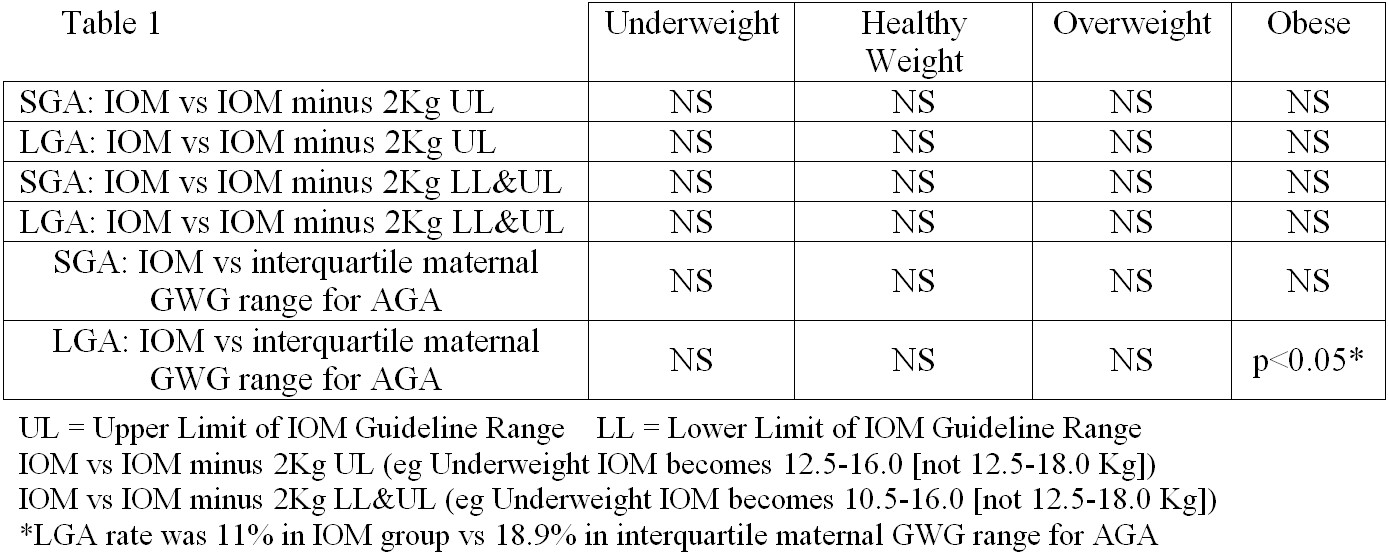Oral Presentation Australian Diabetes Society and the Australian Diabetes Educators Association Annual Scientific Meeting 2014
Are the Institute of Medicine targets for pregnancy weight gain appropriate in women with Gestational diabetes? (#142)
Background: The Institute of Medicine(IOM)1,2 has published weight gain targets according to pre-pregnancy BMI. These criteria are intended for normal pregnancies but may be excessive for women with gestational diabetes(GDM).
Aims: To compare gestational weight gain(GWG) in women with small(SGA), appropriate(AGA) and large(LGA) for gestational age infants. and assess birthweight when IOM targets were modified.
Methods: We analysed de-identified prospectively collected data(1993-2013), for women diagnosed by ADIPS(1998) criteria, comparing those with complete data including; pre-pregnancy BMI(using self-reported weight), last clinic weight recorded <4weeks pre-delivery, and birth outcomes. We compared GWG in women with SGA, AGA and LGA infants against recommended IOM GWG ranges, across four BMI Categories; Underweight(BMI<18.5kg/m2); Healthy Weight(BMI≥18.5≤24.9kg/m2); Overweight(BMI≥25≤29.9kg/m2); Obese(BMI≥30kg/m2) using box-plots. We thence compared SGA and LGA rates in women achieving GWG according to three targets ranges; IOM upper limit minus 2kg; IOM upper and lower limit minus 2kg, and a range matching the interquartile maternal GWG range for AGA infants in our cohort. Birthweights were categorized SGA(<10th percentile) and LGA(>90th percentile) using www.gestation.net3.
Results:There were 3181 records with GWG and birthweight data: 123 Underweight(3.9%), 1463 Normal Weight(46.0%), 854 Overweight(26.8%) and 741 Obese(23.3%). In all BMI categories, median maternal GWG was highest with LGA and lowest with SGA infants. The range of GWG was broad in AGA infants, even with outliers excluded(Figure1). Table 1 shows results of comparing the effect of three target ranges on SGA and LGA rates. Although the distribution and median GWG of AGA infants were different to IOM targets in all BMI categories(Figure 1), there was no reduction in SGA or LGA if target weight gain ranges were modified(Table 1).
%2029-5-14.jpg)
 Conclusions: Changing GWG targets did not yield improvements in birthweight (with more LGA in one instance) and thus does not support recommending changing GWG targets in GDM women.
Conclusions: Changing GWG targets did not yield improvements in birthweight (with more LGA in one instance) and thus does not support recommending changing GWG targets in GDM women.
Acknowledgements: We thank the Diabetes Educators who collected data and maintained the database and Professor Jason Gardosi for permission to use his bulk centile calculator.
- Institute of Medicine, National Academy of Sciences. Nutrition During Pregnancy. Washington DC: National Academy Press, 1990.
- Institute of Medicine and National Research Council. Weight Gain During Pregnancy: Reexamining the Guidelines. Washington DC: The National Academies Press, 2009.
- Gardosi J, Francis A. Customised Weight Centile Calculator – GROW-Centile v5.15/6.4 2009. Gestation Network, www.gestation.net (v5.15: individual; v6.4: bulk centiles).